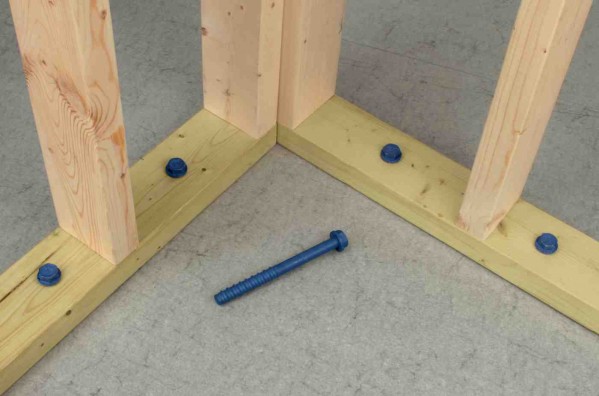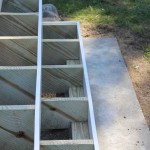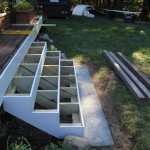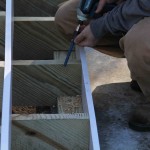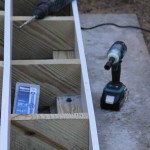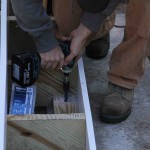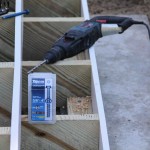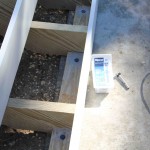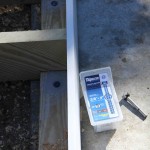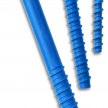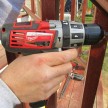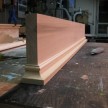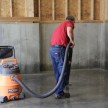Large Diameter Tapcons
Using Large Diameter Tapcons To Secure Stairs To A Concrete Footing
Tapcon is a brand well known for it’s blue concrete or masonry screws that tap threads into concrete. As a residential contractor I have always found Tapcons simple to use and a go to masonry fastener with excellent holding values. If used properly, Tapcon masonry fasteners can work well in most masonry materials, such as mortar, brick, block or concrete.
The Tapcon brand masonry anchor is one of the most versatile products used for fastening to brick, block and solid concrete. Tapcons are available in two different diameters as well as in two head styles in order to meet a variety of different product installation requirements.
How They Work
Tapcon masonry screws work by tapping threads into the side wall of a pre-drilled hole in masonry. The key point that many a folk miss is the pre-drilled hole in the masonry must first be drilled using the correct size and properly matched tolerance masonry bit. Once the proper size hole is drilled the tapcon screw can be installed. As the tapcon is driven into the hole the lead thread taps threads cut away masonry material until the screw is threaded and securely embedded.
Large Diameter Tapcon Sizes
For many years tapcon has been available in numerous sizes and are manufactured in two different head styles: the hex slotted washer head and the flat Phillips counter sunk. Now they are available in larger diameter sizes.
A larger version is now available and available in 3/8”, 1/2″, 5/8″ and 3/4″ sizes are available. These anchors come with or without a EnvireX coating which provides additional corrosion protection for outdoor applications. They are also available in stainless steel.
Large Diameter Tapcon Features: 
- Available in 3/8″ and 1/2″ with and without EnvireX™ coating.
- Available in 5/8″ and 3/4″ Sawtooth™.
- Sawtooth™ design offers improved performance in large diameter holes.
- Superior performance to wedge anchor.
- Installs faster than wedge anchors or adhesive anchors.
- Removable
- Single piece design, no nut and washer to assemble .
- No special proprietary installation bits needed .
Using Tapcons To Secure Stair Stringers:
We build and repair a lot of decks. One weak spot we often encounter is the connection of the stair stringer to the concrete footing pad. It seems alot of carpenters choose to nail a pressure treated cleat to the bottom of their stringers and then pour a pad the concrete up and over the p.t. cleat.
While that will certainly hold the stringers in place it does not allow you to later go back and cleanly repair or replace the stringers and often ruins the footing.
We use large diameter Tapcons to make this connection – they are corrosion resistant, ensure a strong connection and can be removed. The problem with using Tapcons is that a lot of folks don’t know how to use them correctly.
Common Errors Using Tapcons:
I’ve seen and heard of Tapcon failures in masonry and it has always come down to two factors:
- Improper diameter pre-drilling.
- Improper depth of fastener.
- Wrong application
The minimum depth or embedment of a Tapcon screw is 1” and the maximum depth is 1-3/4”. The threads on all Tapcon screws are a maximum length of 1-3/4” and longer screws are used depending on the thickness of the material it needs to travel through to fasten.
Pre-Drilling:
The bit diameter required for all Tapcon screws is slightly smaller than the designated diameter of the screw being installed and must also be drilled 1/4” deeper than the concrete screw will penetrate the base material. This allows space for the material that the threads remove as it taps the base material. If the hole is not drilled deep enough, the material may build up to the point where the Tapcon® screw will bottom out before it is able to secure the material being fastened. If this should happen, it is possible that the screw will over torque and shear off.
Proper Depth:
Unlike most other types of concrete screws where deeper embedment will provide better holding values, using deeper embedment with Tapcons will create an installation problem. The leading edge of these concrete screws are doing the cutting of the base material, whether it is concrete, brick or block. This cutting action deteriorates the leading edge of the thread and between 1” and 1-3/4” of the base material may deteriorate to the point where it is unable to perform.
To determine the longest Tapcon that can be used, add the thickness of the material to be fastened to the maximum embedment of 1-3/4″. These two measurements will give you the length of Tapcons to use.
Wrong Application:
If the material is too abrasive and the lead thread is worn down during installation, the Tapcon® screw will stop tapping threads. This continued torque on the screw can shear the Tapcon in half. Applications like this may warrant the use of a hammer drive or split drive concrete anchor.
Outdoor Considerations
Many folk do not know that the Tapcon blue color is a result of a special coating called Climaseal® which is a Thermosetting polyester coating designed to provide rust resistance. This exceptional coating works well and makes the Tapcon screw an excellent choice for outdoor use.
When using Tapcons in outdoor applications, it is important to take into account many different environmental factors. These factors include: if the Tapcon will be in a moist environment, if it will be submerged in water or other liquids, all of which increase the opportunity for rusting.
Installing A Tapcon Screw
- Using a hammer drill and a carbide tipped masonry bit meeting ANSI standards, drill a hole with the required diameter of Tapcon masonry screw being installed.
- Note – make sure that the depth of the hole will be a minimum of 1/2” deeper than the Tapcon concrete screw will penetrate.
- Blow dust and debris out of hole.
- Move the item being fastened and align the hole over the hole in the base material.
- Insert Tapcon concrete screw through hole in the fixture and into the hole in the base material.
- Fasten the Tapcon concrete screw tight against the surface of the fixture being installed. Make sure that the Tapcon concrete screw is not over-torqued to avoid stripping the threads in the base material and cause the Tapcon concrete screw to spin in the hole.




